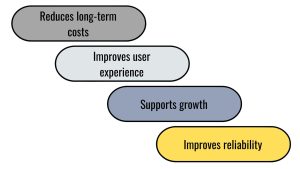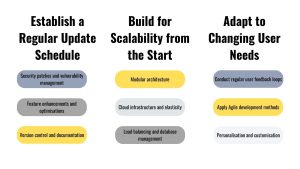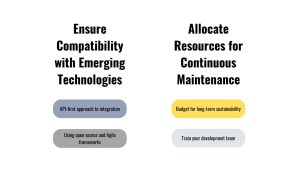Planning for Long-Term Software Sustainability
Introduction In today’s rapidly changing digital landscape, software systems are an integral part of business operations. However, without a well-thought-out long-term mainten...

Introduction
In today’s rapidly changing digital landscape, software systems are an integral part of business operations. However, without a well-thought-out long-term maintenance plan, even the most robust software solutions can become outdated or ineffective. Ensuring software sustainability over time requires proactive planning, regular updates, and the ability to adapt to changing user needs and technological advances. This article outlines the key components of planning for long-term software sustainability, including regular updates, scalability considerations, and strategies for changing user needs.
Why Long-Term Software Sustainability Matters
Software maintenance isn’t just about fixing bugs or patching security vulnerabilities. It’s about ensuring that the system remains functional, scalable, and adaptable as your business grows, new technologies emerge, and user expectations change. A sustainable software system:
- Reduces long-term costs by preventing major overhauls or unexpected system failures.
- Improves user experience by staying current and responsive.
- Supports growth by allowing easy scaling and integration with new tools.
- Improves reliability by providing regular updates and proactive improvements.

Let’s break down the process of creating a resilient software maintenance plan into manageable steps.
1. Establish a Regular Update Schedule
Regular updates are the foundation of any software maintenance plan. These updates not only keep your software running, but also ensure that it is compatible with the latest technologies, security standards, and performance requirements.
Security patches and vulnerability management
One of the most important reasons for regular updates is security. Cyber threats are constantly evolving, and outdated software can be an easy target for hackers. To protect sensitive data and maintain user trust, regular security patches are non-negotiable. Integrating automated security monitoring tools that alert your team to vulnerabilities will allow you to act quickly and deploy patches before breaches occur.
Feature enhancements and optimisations
In addition to security, updates provide opportunities to optimise performance and improve features. As your software evolves, there may be parts of the system that can be improved to improve speed, efficiency, or usability. Regularly auditing the performance of your software helps identify areas where improvements can create a smoother, more efficient user experience.
Version control and documentation
Efficient version control is the key to smooth upgrade management. By creating a robust version control system, you ensure that all changes are tracked and documented, giving your team an organised history of software development. Along with maintaining documentation of new features and changes to the system, having comprehensive version control makes it easier to debug and roll back if problems arise.
2. Build for Scalability from the Start
A sustainable software system must be designed with scalability in mind. As your business grows and your users’ needs increase, your software must be able to handle additional users, data, and functionality without having to be completely redesigned. Here’s how to plan for long-term scalability.
Modular architecture
Designing your software with a modular architecture ensures that it can grow and change without breaking the core functionality. Modular design breaks your system into smaller, manageable components or modules that can be updated or replaced independently. This provides greater flexibility when scaling and integrating new features or technologies.
Cloud infrastructure and elasticity
Using cloud infrastructure is one of the most effective ways to ensure scalability. Cloud environments provide the elasticity needed to scale resources up or down based on demand. This flexibility is critical for businesses with unstable traffic or growing data storage needs. Platforms like AWS, Microsoft Azure, or Google Cloud can be invaluable partners in maintaining a sustainable software system.
Load balancing and database management
As your software scales, managing load distribution becomes vital. Load balancing ensures that no single server bears the brunt of incoming traffic, thereby preventing failures and downtime. Additionally, scalable database management is essential to ensure that your system can handle increasing volumes of data. Optimising database queries, using database replication, and adopting scalable database architectures such as NoSQL can support long-term growth.
3. Adapt to Changing User Needs
Your software will only remain sustainable if it can evolve with the needs of your users. User behaviour, expectations, and requirements can change over time due to market trends, new technologies, or simply changing preferences. Here’s how to keep your software up to date.
Conduct regular user feedback loops
One of the most effective ways to stay on top of changing user needs is to implement regular feedback loops. Surveys, user interviews, and data analytics provide insight into what users value most and where they encounter pain points. By acting on this feedback, you can prioritise updates that improve usability and customer satisfaction.
Apply Agile development methods
Agile methodologies allow teams to respond quickly to user needs and market changes. By adopting agile development methods, your development team can release updates in smaller, more frequent increments, ensuring faster response times and a continuous stream of improvements. This approach also makes it easier to adapt to new trends or customer demands, helping your software stay competitive in a rapidly changing environment.
Personalisation and customisation
Offering a personalised experience is becoming increasingly important in software development. By including customisation options, you can allow users to tailor the system to their specific needs. Additionally, integrating machine learning algorithms can help identify patterns in user behaviour, allowing you to offer personalised recommendations or automatic adjustments that improve the overall user experience.

4. Ensure Compatibility with Emerging Technologies
Technology is constantly evolving, and it’s important to ensure that your software is built to handle new developments. By proactively planning for technology shifts, you can avoid costly upgrades or complete system redesigns.
API-first approach to integration
An API-First approach enables seamless integration with third-party tools and platforms. This is important for long-term sustainability, as new technologies or systems will likely require integration over time. Having a robust API allows your software to communicate and exchange data with other applications, ensuring that you can adapt to technological advances without reengineering your system.
Using open source and Agile frameworks
Using open source tools and Agile frameworks can greatly improve the sustainability of your software. Open source technologies tend to have active communities that promote continuous improvement and security of the software. Moreover, flexible frameworks allow developers to easily modify or extend the software, ensuring that it remains adaptable to new standards and technologies.
5. Allocate Resources for Continuous Maintenance
A long-term software maintenance plan requires an ongoing investment in both human and financial resources. Failure to allocate sufficient resources can result in rushed updates, poor-quality fixes, or unaddressed vulnerabilities.
Budget for long-term sustainability
When planning your software project, it is critical to budget for ongoing maintenance from the start. This should include regular updates, security monitoring, performance audits, and user feedback initiatives. By integrating maintenance costs into long-term financial planning, you can avoid the common mistake of underfunding software maintenance, which often leads to technical debt.
Train your development team
Make sure your development team is equipped with the latest knowledge and tools to maintain the sustainability of your software. Regular training and refresher courses on new technologies, security standards, and scalable development best practices will keep them ahead of the curve. A knowledgeable and skilled team is the foundation of long-term software sustainability.

Conclusion
Long-term software sustainability is an ongoing commitment, not a one-time effort. By proactively planning for regular updates, scalability, changing user needs, and new technologies, you can ensure that your software remains valuable and functional over time. A well-maintained and scalable system not only improves user satisfaction, but also contributes to the overall growth and success of your business.
With a clear and comprehensive software maintenance plan, businesses can remain agile, competitive, and ready to adapt to any future changes.